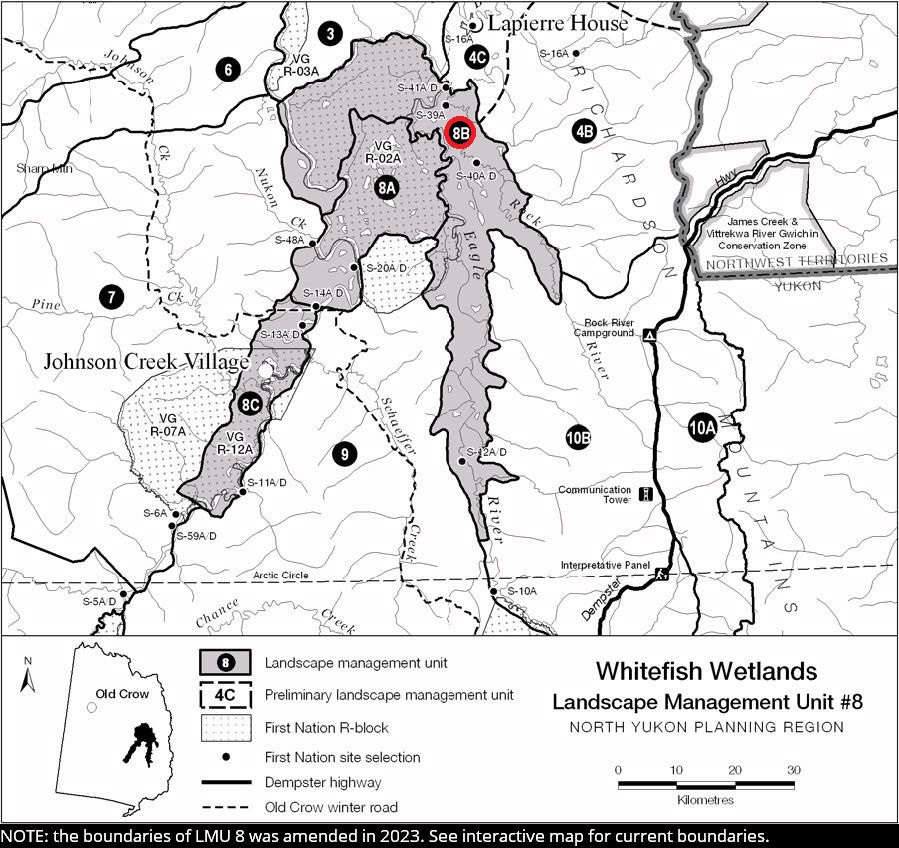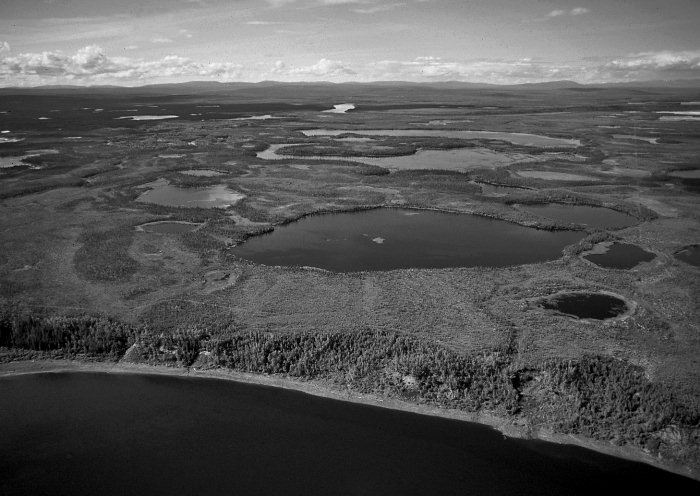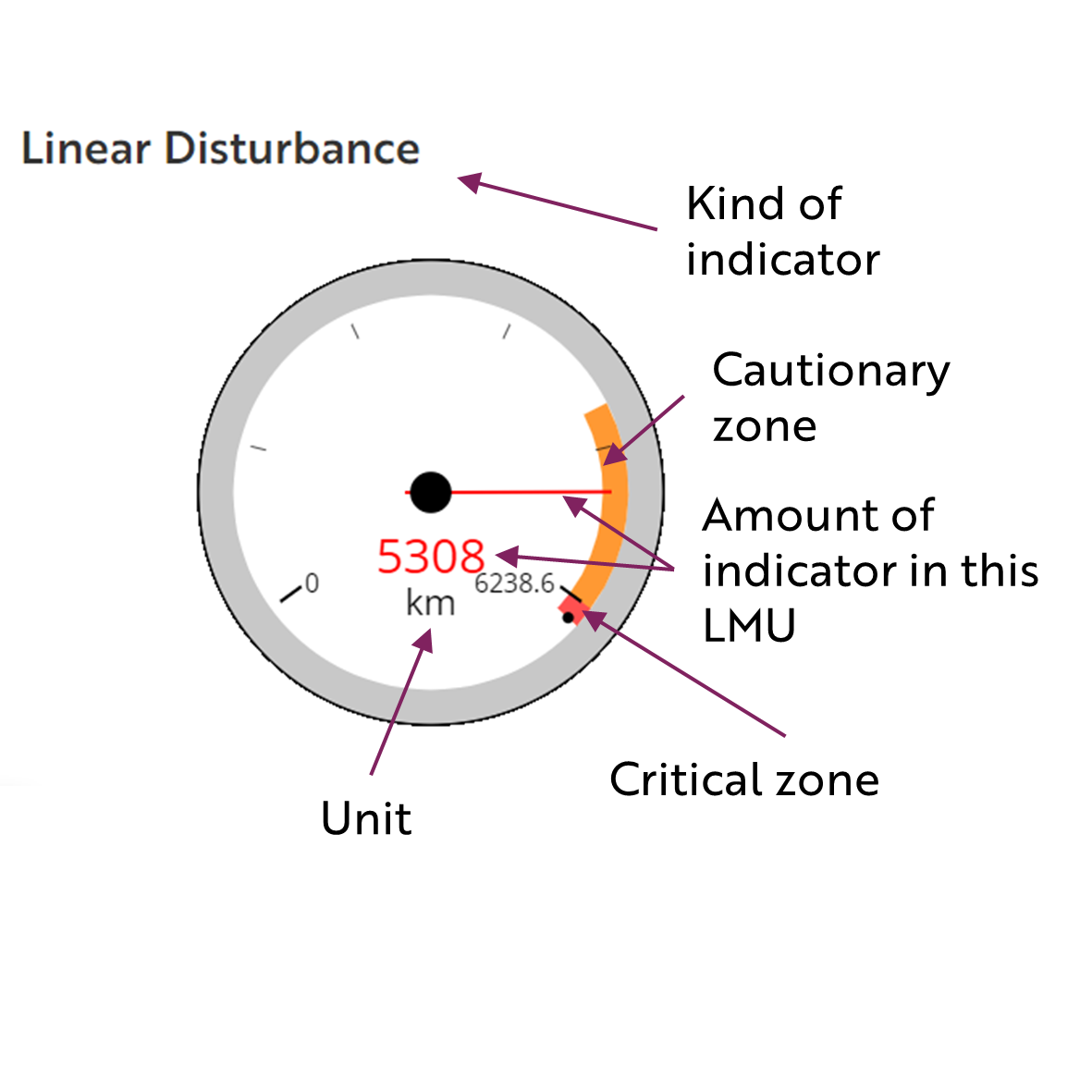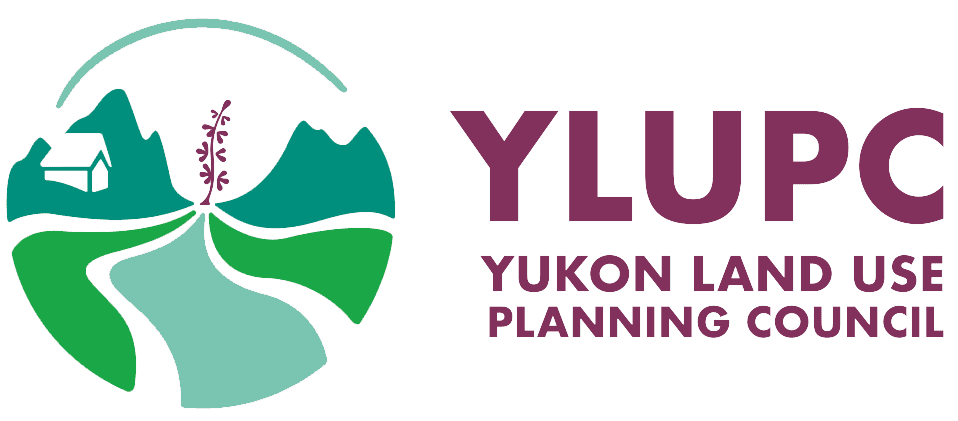NORTH YUKON PLANNING REGION:
LMU 8: Whitefish Wetlands
Sub-unit #8B: Eagle – Bell River
Land Use Designation
Integrated Management Area, Zone I
Land Status
Yukon public land and VGFN Settlement land (VG R-02A and a number of S-sites)
Traditional Territories
Vuntut Gwitchin First Nation and Tetlit Gwich’in Secondary Use Area
Area
1,026 km2 (1.7% of Region)
Implementation News
This LMU was divided into two sections as part of the on-going creation of Dàadzàii Vàn Territorial Park. These boundary amendments occured in 2023. See our interactive map for current boundaries.

Biophysical Setting (LMU 8)
Setting
Large wetland and riparian complex within rolling Eagle Plains plateau.
Ecoregions
Eagle Plains.
Bioclimatic Zones
Taiga Wooded.
Habitat Types
Low elevation wet herb, shrub and coniferous forest; variety of wetland types, riparian and open water.
Watersheds
Porcupine River (perched wetlands flow to Porcupine, Eagle and Bell rivers).
Image Explanation
Central Whitefish wetlands complex, LMU #8A (CWS photo)

Cumulative Effects Thresholds
Relative to LMU Size*
Surface Disturbance (%)
Linear Disturbance (km/km2)
Current disturbance (2020)
0.225
0.303
Cautionary
0.075
0.075
Critical
0.100
0.100
On the ground amounts**
Surface Disturbance (km2)
Linear Disturbance (km)
Current disturbance (2020)
2.31
310.5
Room under cautionary threshold***
-1.54
-233.6
Cautionary
0.77
77.0
Critical
1.03
102.6
*These are proportional to the size of the LMU, and correspond to table 3-2 of the Approved Plan. They are measured in the % of the LMU that can be disturbed (“Surface Disturbance”) and in km/km2 (“Linear Disturbance Density”).
**These are amounts that can be measured and apply to the whole LMU and would be more familiar to project proponents and regulators. They are measured in km2 of disturbance and in km of linear disturbance (e.g., roads, trails and cutlines).
***How much more disturbance can be added to existing disturbance before the cautionary threshold is reached.
Cumulative Effects Indicators
Surface Disturbance
Linear Disturbance
Cautionary
Critical
Ecological Resources
Porcupine Caribou
Concentrated caribou use during fall rutting and winter seasons.
Moose
Significant habitats in all seasons.
Marten
Moderate quality winter habitat.
Sheep
No sheep populations.
Fish
Identified and potential over-wintering habitat in Eagle, Bell and Rock rivers
Other Species
Significant bear, waterbird and beaver habitats.
Wetlands and Lakes
With exception of low hills south of Bell River, most of unit contains wetlands and lakes.
Riparian Areas
Most of unit contains riparian habitat.
Major River Corridors
Eagle and Bell rivers
Heritage, Social and Cultural Resources
VGFN Heritage Routes and Sites
Johnson Creek Village to LaChute River via Whitefish Lake, and Whitestone Village route via Upper Stony Creek. Important traditional use and culturally significant area for both VGFN and Tetlit Gwich’in.
Other Heritage and Historic Resources
Significant heritage resource values. Documented archaeological and palaeontological sites.
Current Community Use Areas
Much of unit receives seasonal harvesting use.
Economic Development
Transportation and Access
No existing transportation infrastructure.
Traditional Economy
Multi-season subsistence harvesting and general land use.
Tourism and Recreation
Low activity (outside of Eagle River corridor); Eagle and Bell river have high wilderness tourism value and interest.
Oil and Gas Resources
High potential; Eagle Plain oil and gas basin.
Mineral Resources
Low or no potential.
Aggregate (Gravel) Resources
Preliminary aggregate assessment available for upper Eagle River; potential sources identified in high river terraces.
Special Management Considerations
- In the IMA, Zone I designation identifies high ecological and cultural values within a sensitive biophysical setting. All-season infrastructure is discouraged.
- Tetlit Gwich’in Secondary Use Area.
These gauges show how much of each disturbance indicator there is in the LMU with the needle and the large number near the middle. The colours indicate disturbance level zones or thresholds. If the needle is in the white zone, no threshold has been reached.
The Dawson Planning Commission gives a details of their similar (but slightly different) Cumulative Effects Framework on their website.

Cautionary
Critical
